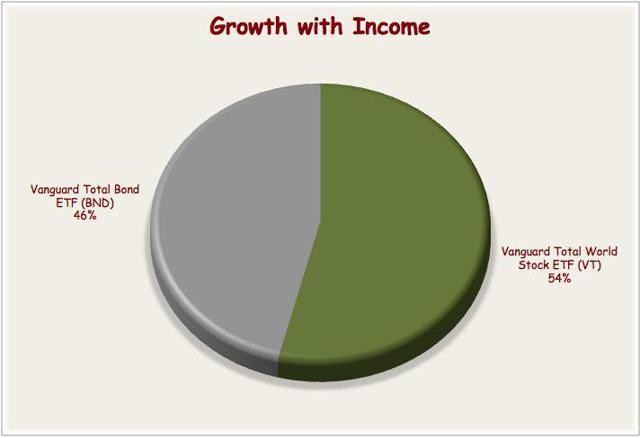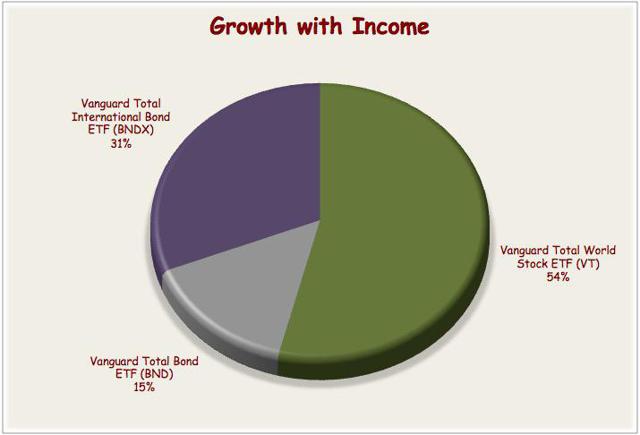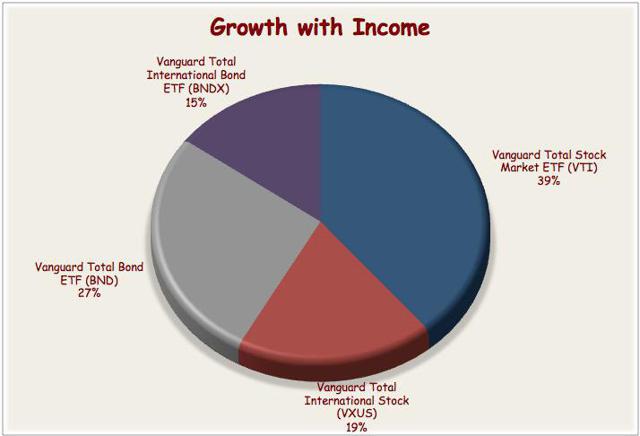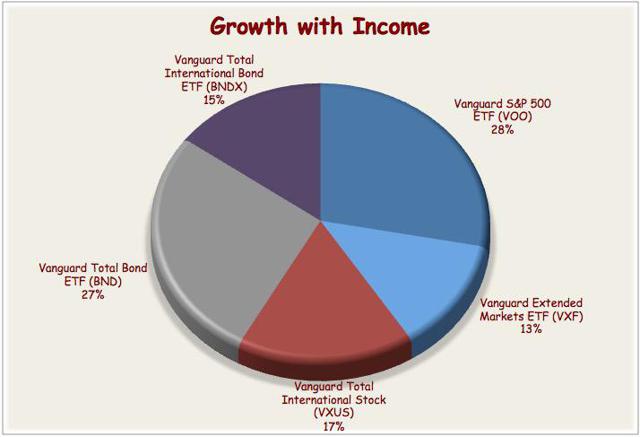Scalper1 News



 Originally published on Jan. 26, 2015 Vanguard Diversification With 4 Easy-to-Copy Portfolios Vanguard ETFs and Index Funds are the optimum vehicles for creating a globally balanced portfolio. With just a few holdings, you can have exposure to thousands of stocks and bonds from around the world. One of the primary ways to create good diversified portfolios is to use vehicles that track an index. Vanguard started the first index fund and their ability to track an index is legendary. Another advantage of tracking an index is the lower cost of not having to pay for an expensive manager who often falls behind an index even without the higher cost. Vanguard is the low cost leader and it keeps getting cheaper. The amount of money invested in Vanguard Funds is growing rapidly. The more money a fund has, the more efficient its cost structure, and because Vanguard is run like a credit union they keep passing along their savings. This creates a fee-lowering circle. A lower fee attracts more money to the funds, which then keeps the fees dropping. I have researched the Vanguard ETFs list and will present Vanguard’s best diversified ETFs for a two, three, four or five position Vanguard ETF globally balanced portfolio. Examples: Vanguard Diversified Portfolios Using the Best Diversified ETFs I will present a portfolio for each mixture that is made using the Efficient Frontier and the Black-Litterman model. I will target each portfolio at approximately 60% of the risk of the S&P 500 Index (0.60 Beta). I call this type of portfolio my Growth with Income portfolio. See “How to Make an Investment Portfolio: 6 Steps to Better Investing” for a full understanding of how to make the best index portfolio. Best Vanguard Diversified Portfolio with Two ETFs – Using Vanguard’s Best Diversified ETFs Vanguard Total World Stock Index ETF (NYSEARCA: VT ) or (MUTF: VTWSX ) – This Vanguard Total World Stock review starts with the very low expense ratio. With an expense ratio of 0.18%, this fund tracks the FTSE Global All Cap Index, a market-cap weighted index of global stocks covering 98% of the developed and emerging market capitalization with approximately 7,240 large-, mid-, small-, and micro-cap stocks located in 50 countries. This fund employs a sampling method and currently owns 5,351 of the stocks from this index. However, this Vanguard world stock ETF does not hold exposure to frontier markets. Vanguard Total Bond Market ETF (NYSEARCA: BND ) or (MUTF: VBTLX ) – This fund is at the top of the Vanguard bond ETF list, providing superior inexpensive U.S. bond coverage. With an expense ratio of 0.08%, BND tracks the Barclays U.S. Aggregate Float Adjusted Index. It covers a wide range of public, investment-grade, taxable bonds in the United States-including government, corporate, and international dollar-denominated bonds, as well as mortgage-backed and asset-backed securities- all with maturities of more than one year. The ETF invests by sampling the Index and currently holds 6,166 bonds. BND does not provide exposure to ultra-short, high yield or TIPS bonds. (click to enlarge) Pros If we had to vote for one ETF on our Vanguard Best ETF Index Fund List, this Vanguard World ETF would be it. This extremely efficient, low cost, Vanguard all-in-one fund, world ETF covers 98% of the developed and emerging markets capitalization. Many other portfolios have considerable turnover, and trading as stocks migrate from one asset class to another. For example, a stock in your portfolio may move from your mid-cap ETF to your large-cap ETF simply because the market cap changed. You still own the company, but internal trading costs were increased with possible tax consequences when the stock moved. A global total market ETF, such as VT ETF, greatly reduces the stock migration costs because the stocks do not need to change ETFs. BND offers the same great broad coverage of U.S. bonds. With just two holdings, which you can purchase for free in a Vanguard Brokerage account, you will own 5,351 stocks and 6,166 bonds with a blended expense ratio of only 0.13%. Cons The first downside to this two-part portfolio is the lack of flexibility. The best index portfolio would have more ability to control the overall risk of your portfolio. You have no way to control the amount or types of the stocks or bonds in your portfolio. For example, you cannot add more small cap stocks or long-term bonds if you think these are needed. The main disadvantage of this portfolio is the lack of international bonds, which make up roughly 35% of the world’s capitalization of stocks and bonds. Generally, money moves unpredictably from asset class to asset class. If you have a big hole in your portfolio you will have periods of under performance. Best Vanguard Diversified Portfolio with Three ETFs – Using Vanguard’s Best Diversified ETFs Vanguard Total World Stock Index ETF ( VT ) or ( VTWSX ) – See details in previous portfolio. Vanguard Total Bond Market ETF ( BND ) or ( VBTLX ) – See details in previous portfolio. Vanguard Total International Bond ETF (NASDAQ: BNDX ) or (MUTF: VTABX ) – With an expense ratio of 0.20%, this fund tracks the investment-grade Barclays Global Aggregate ex-USD Float Adjusted RIC Capped Index (USD Hedged). The Index includes government, government agency, corporate, and securitized non-U.S. investment-grade fixed income investments, all issued in currencies other than the U.S. dollar and with maturities of more than one year. To minimize the currency risk, the ETF will attempt to hedge its currency exposures. The ETF currently holds 2,246 bonds. BNDX does not include ultra-short, high-yield or TIPs international bonds. (click to enlarge) Pros Incredibly, with just three very efficient, low-cost ETFs you can hold 5,351 stocks and 8,412 bonds. Stock and bond migration costs are low to non-existent in this mixture of ETFs. You now have nearly full exposure to U.S. stocks and bonds as well as international stocks and bonds. The weighted average cost of this vastly diversified portfolio is only 0.18%, which is significantly cheaper than the average Mutual Fund at 1.27%, the average Index Fund at 0.74% and the average ETF at 0.61%. Cons These are market-cap weighted indexes, which means that mid and small cap U.S. stocks and emerging markets will not have as much impact on the portfolio as the large cap stocks. The ability to really fine-tune risk is limited with only three ETFs. In 2003, I implemented this portfolio with my 600 asset management clients. The portfolio did fantastic. The clients hated it. I had so many clients leaving that I had to abandon the concept after only one year. When they got a statement for the accounts that held their life savings and all they saw were three holdings from the same company, they got extremely nervous. We actually printed out, in book form, an entire list of all of the holdings to demonstrate the extreme diversification. We were confident that these clients had never been more diversified at any point in their lives, but they still left in droves. For some investors, three is just not enough. Best Vanguard Diversified Portfolio with Four ETFs – Using Vanguard’s Best Diversified ETFs Vanguard Total Stock Market ETF (NYSEARCA: VTI ) or (MUTF: VTSAX ) – With an extremely low expense ratio of only 0.05%, this ETF tracks the CRSP US Total market Index, which represents approximately 100% of the investable U.S. stock market and includes large-, mid-, small-, and micro-cap stocks. This ETF invests by sampling the Index, and currently holds 3,657 stocks. See “Sample Vanguard ETF Portfolio: 4 Ways to Cover U.S. Stocks” for additional methods of covering the U.S. stock market. Vanguard Total International Stock ETF (NASDAQ: VXUS ) or (MUTF: VTIAX ) – I consider this fund the overall best international stock ETF. With an expense ratio of just 0.14%, this Vanguard International ETF tracks the market-cap weighted FTSE Global All Cap ex US Index, which covers 99% of the world’s global market capitalization outside the US. This Vanguard International Stock Index holds 5,512 large-, mid-, small- and micro-cap stocks from 46 developed and emerging markets. This ETF does not cover the frontier markets. Vanguard Total Bond Market ETF ( BND ) or ( VBTLX ) – See details in previous portfolio. Vanguard Total International Bond ETF ( BNDX ) or ( VTABX ) – See details in previous portfolio. (click to enlarge) Pros With just four low-cost ETFs you can hold 9,169 stocks and 8,214 bonds. Stock and bond migration costs are low to non-existent, and this mixture has a fairly good ability to add or subtract risk. The number of stocks is greatly increased versus the three part portfolio, and the split of U.S. and International stocks provides some opportunity to make money from rebalancing. The blended average expense ratio is a very low 0.10%. Cons Although the diversification is extreme, some investors may still shy away from investing considerable money in just four holdings. Adding ETFs for ultra-short, high yield or TIPS bonds or frontier market stocks, which is not covered in this portfolio, may make these investors more comfortable. Best Vanguard Diversified Portfolio with Five ETFs – Using Vanguard’s Best Diversified ETFs Vanguard S&P 500 ETF (NYSEARCA: VOO ) or (MUTF: VFIAX ) – With an expense ratio of 0.05%, this ETF tracks the wildly popular market-cap weighted S&P 500 Index. The ETF fully replicates the Index and is dominated by the stocks of large U.S. companies. Vanguard Extended Markets ETF (NYSEARCA: VXF ) or (MUTF: VEXAX ) – With an expense ratio of 0.10%, this ETF tracks the market-cap weighted S&P’s Completion Index. This index contains all of the U.S. common stocks regularly traded on the New York Stock Exchange and the Nasdaq over-the-counter market, except those stocks included in the S&P 500 Index. The ETF uses a sampling method to replicate the index and currently holds 3,078 stocks. Vanguard Total International Stock ETF ( VXUS ) or ( VTIAX ) – See details in previous portfolio. Vanguard Total Bond Market ETF ( BND ) or ( VBTLX ) – See details in previous portfolio. Vanguard Total International Bond ETF ( BNDX ) or ( VTABX ) – See details in previous portfolio. (click to enlarge) Pros Using this mixture of ETFs allows you to fine-tune your risk level by controlling your exposure to mid and small cap U.S. stocks, while including coverage of international stocks and bonds. These five ETFs give you exposure to 9,090 stocks and 8,214 bonds. This portfolio has a low blended expense ratio of 0.10%. I found that this was a very popular portfolio. Investors liked at least five holdings, and although the S&P 500 is included in the all of the previous portfolios, there was more comfort in seeing it directly in the portfolio. Having more parts in the portfolio increases the possibility of rebalancing gains, especially if you do not have to pay capital gains taxes by using a tax-deferred account such as an IRA. The commissions are free, which can be accomplished in a Vanguard Brokerage account. Cons Stock migration costs will be higher when you divide the market into small pieces. Disclosure: Author has holdings in BIV, BLV, BND, BNDX, BSV, IJS, IXP, JKL, RYU, RZV, SCV, VBK, VIG, VOO, VPU, VTI, VWO, VXF, VXUS, XLU. Scalper1 News
Originally published on Jan. 26, 2015 Vanguard Diversification With 4 Easy-to-Copy Portfolios Vanguard ETFs and Index Funds are the optimum vehicles for creating a globally balanced portfolio. With just a few holdings, you can have exposure to thousands of stocks and bonds from around the world. One of the primary ways to create good diversified portfolios is to use vehicles that track an index. Vanguard started the first index fund and their ability to track an index is legendary. Another advantage of tracking an index is the lower cost of not having to pay for an expensive manager who often falls behind an index even without the higher cost. Vanguard is the low cost leader and it keeps getting cheaper. The amount of money invested in Vanguard Funds is growing rapidly. The more money a fund has, the more efficient its cost structure, and because Vanguard is run like a credit union they keep passing along their savings. This creates a fee-lowering circle. A lower fee attracts more money to the funds, which then keeps the fees dropping. I have researched the Vanguard ETFs list and will present Vanguard’s best diversified ETFs for a two, three, four or five position Vanguard ETF globally balanced portfolio. Examples: Vanguard Diversified Portfolios Using the Best Diversified ETFs I will present a portfolio for each mixture that is made using the Efficient Frontier and the Black-Litterman model. I will target each portfolio at approximately 60% of the risk of the S&P 500 Index (0.60 Beta). I call this type of portfolio my Growth with Income portfolio. See “How to Make an Investment Portfolio: 6 Steps to Better Investing” for a full understanding of how to make the best index portfolio. Best Vanguard Diversified Portfolio with Two ETFs – Using Vanguard’s Best Diversified ETFs Vanguard Total World Stock Index ETF (NYSEARCA: VT ) or (MUTF: VTWSX ) – This Vanguard Total World Stock review starts with the very low expense ratio. With an expense ratio of 0.18%, this fund tracks the FTSE Global All Cap Index, a market-cap weighted index of global stocks covering 98% of the developed and emerging market capitalization with approximately 7,240 large-, mid-, small-, and micro-cap stocks located in 50 countries. This fund employs a sampling method and currently owns 5,351 of the stocks from this index. However, this Vanguard world stock ETF does not hold exposure to frontier markets. Vanguard Total Bond Market ETF (NYSEARCA: BND ) or (MUTF: VBTLX ) – This fund is at the top of the Vanguard bond ETF list, providing superior inexpensive U.S. bond coverage. With an expense ratio of 0.08%, BND tracks the Barclays U.S. Aggregate Float Adjusted Index. It covers a wide range of public, investment-grade, taxable bonds in the United States-including government, corporate, and international dollar-denominated bonds, as well as mortgage-backed and asset-backed securities- all with maturities of more than one year. The ETF invests by sampling the Index and currently holds 6,166 bonds. BND does not provide exposure to ultra-short, high yield or TIPS bonds. (click to enlarge) Pros If we had to vote for one ETF on our Vanguard Best ETF Index Fund List, this Vanguard World ETF would be it. This extremely efficient, low cost, Vanguard all-in-one fund, world ETF covers 98% of the developed and emerging markets capitalization. Many other portfolios have considerable turnover, and trading as stocks migrate from one asset class to another. For example, a stock in your portfolio may move from your mid-cap ETF to your large-cap ETF simply because the market cap changed. You still own the company, but internal trading costs were increased with possible tax consequences when the stock moved. A global total market ETF, such as VT ETF, greatly reduces the stock migration costs because the stocks do not need to change ETFs. BND offers the same great broad coverage of U.S. bonds. With just two holdings, which you can purchase for free in a Vanguard Brokerage account, you will own 5,351 stocks and 6,166 bonds with a blended expense ratio of only 0.13%. Cons The first downside to this two-part portfolio is the lack of flexibility. The best index portfolio would have more ability to control the overall risk of your portfolio. You have no way to control the amount or types of the stocks or bonds in your portfolio. For example, you cannot add more small cap stocks or long-term bonds if you think these are needed. The main disadvantage of this portfolio is the lack of international bonds, which make up roughly 35% of the world’s capitalization of stocks and bonds. Generally, money moves unpredictably from asset class to asset class. If you have a big hole in your portfolio you will have periods of under performance. Best Vanguard Diversified Portfolio with Three ETFs – Using Vanguard’s Best Diversified ETFs Vanguard Total World Stock Index ETF ( VT ) or ( VTWSX ) – See details in previous portfolio. Vanguard Total Bond Market ETF ( BND ) or ( VBTLX ) – See details in previous portfolio. Vanguard Total International Bond ETF (NASDAQ: BNDX ) or (MUTF: VTABX ) – With an expense ratio of 0.20%, this fund tracks the investment-grade Barclays Global Aggregate ex-USD Float Adjusted RIC Capped Index (USD Hedged). The Index includes government, government agency, corporate, and securitized non-U.S. investment-grade fixed income investments, all issued in currencies other than the U.S. dollar and with maturities of more than one year. To minimize the currency risk, the ETF will attempt to hedge its currency exposures. The ETF currently holds 2,246 bonds. BNDX does not include ultra-short, high-yield or TIPs international bonds. (click to enlarge) Pros Incredibly, with just three very efficient, low-cost ETFs you can hold 5,351 stocks and 8,412 bonds. Stock and bond migration costs are low to non-existent in this mixture of ETFs. You now have nearly full exposure to U.S. stocks and bonds as well as international stocks and bonds. The weighted average cost of this vastly diversified portfolio is only 0.18%, which is significantly cheaper than the average Mutual Fund at 1.27%, the average Index Fund at 0.74% and the average ETF at 0.61%. Cons These are market-cap weighted indexes, which means that mid and small cap U.S. stocks and emerging markets will not have as much impact on the portfolio as the large cap stocks. The ability to really fine-tune risk is limited with only three ETFs. In 2003, I implemented this portfolio with my 600 asset management clients. The portfolio did fantastic. The clients hated it. I had so many clients leaving that I had to abandon the concept after only one year. When they got a statement for the accounts that held their life savings and all they saw were three holdings from the same company, they got extremely nervous. We actually printed out, in book form, an entire list of all of the holdings to demonstrate the extreme diversification. We were confident that these clients had never been more diversified at any point in their lives, but they still left in droves. For some investors, three is just not enough. Best Vanguard Diversified Portfolio with Four ETFs – Using Vanguard’s Best Diversified ETFs Vanguard Total Stock Market ETF (NYSEARCA: VTI ) or (MUTF: VTSAX ) – With an extremely low expense ratio of only 0.05%, this ETF tracks the CRSP US Total market Index, which represents approximately 100% of the investable U.S. stock market and includes large-, mid-, small-, and micro-cap stocks. This ETF invests by sampling the Index, and currently holds 3,657 stocks. See “Sample Vanguard ETF Portfolio: 4 Ways to Cover U.S. Stocks” for additional methods of covering the U.S. stock market. Vanguard Total International Stock ETF (NASDAQ: VXUS ) or (MUTF: VTIAX ) – I consider this fund the overall best international stock ETF. With an expense ratio of just 0.14%, this Vanguard International ETF tracks the market-cap weighted FTSE Global All Cap ex US Index, which covers 99% of the world’s global market capitalization outside the US. This Vanguard International Stock Index holds 5,512 large-, mid-, small- and micro-cap stocks from 46 developed and emerging markets. This ETF does not cover the frontier markets. Vanguard Total Bond Market ETF ( BND ) or ( VBTLX ) – See details in previous portfolio. Vanguard Total International Bond ETF ( BNDX ) or ( VTABX ) – See details in previous portfolio. (click to enlarge) Pros With just four low-cost ETFs you can hold 9,169 stocks and 8,214 bonds. Stock and bond migration costs are low to non-existent, and this mixture has a fairly good ability to add or subtract risk. The number of stocks is greatly increased versus the three part portfolio, and the split of U.S. and International stocks provides some opportunity to make money from rebalancing. The blended average expense ratio is a very low 0.10%. Cons Although the diversification is extreme, some investors may still shy away from investing considerable money in just four holdings. Adding ETFs for ultra-short, high yield or TIPS bonds or frontier market stocks, which is not covered in this portfolio, may make these investors more comfortable. Best Vanguard Diversified Portfolio with Five ETFs – Using Vanguard’s Best Diversified ETFs Vanguard S&P 500 ETF (NYSEARCA: VOO ) or (MUTF: VFIAX ) – With an expense ratio of 0.05%, this ETF tracks the wildly popular market-cap weighted S&P 500 Index. The ETF fully replicates the Index and is dominated by the stocks of large U.S. companies. Vanguard Extended Markets ETF (NYSEARCA: VXF ) or (MUTF: VEXAX ) – With an expense ratio of 0.10%, this ETF tracks the market-cap weighted S&P’s Completion Index. This index contains all of the U.S. common stocks regularly traded on the New York Stock Exchange and the Nasdaq over-the-counter market, except those stocks included in the S&P 500 Index. The ETF uses a sampling method to replicate the index and currently holds 3,078 stocks. Vanguard Total International Stock ETF ( VXUS ) or ( VTIAX ) – See details in previous portfolio. Vanguard Total Bond Market ETF ( BND ) or ( VBTLX ) – See details in previous portfolio. Vanguard Total International Bond ETF ( BNDX ) or ( VTABX ) – See details in previous portfolio. (click to enlarge) Pros Using this mixture of ETFs allows you to fine-tune your risk level by controlling your exposure to mid and small cap U.S. stocks, while including coverage of international stocks and bonds. These five ETFs give you exposure to 9,090 stocks and 8,214 bonds. This portfolio has a low blended expense ratio of 0.10%. I found that this was a very popular portfolio. Investors liked at least five holdings, and although the S&P 500 is included in the all of the previous portfolios, there was more comfort in seeing it directly in the portfolio. Having more parts in the portfolio increases the possibility of rebalancing gains, especially if you do not have to pay capital gains taxes by using a tax-deferred account such as an IRA. The commissions are free, which can be accomplished in a Vanguard Brokerage account. Cons Stock migration costs will be higher when you divide the market into small pieces. Disclosure: Author has holdings in BIV, BLV, BND, BNDX, BSV, IJS, IXP, JKL, RYU, RZV, SCV, VBK, VIG, VOO, VPU, VTI, VWO, VXF, VXUS, XLU. Scalper1 News
Scalper1 News